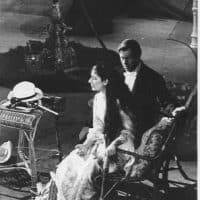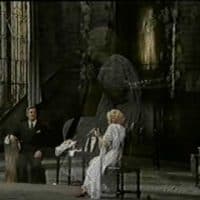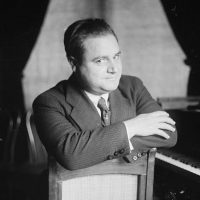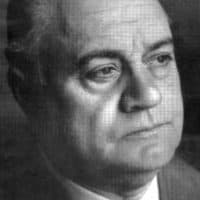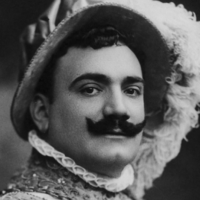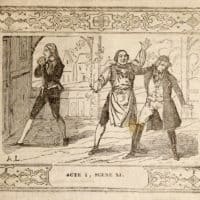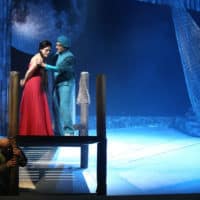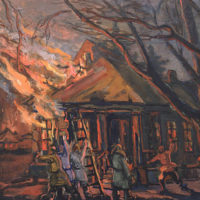1

Giuseppe di Stefano – Pippo – was born on 24 July 1921 at Motta Santa Anastasia, a village near Catania on the island of Sicily, Italy. He was educated at the Jesuit seminary of St. Avialdo in Milano and wanted initially to become a priest of the Catholic church. However, his beautiful voice caused excitement why he decided to take vocal classes. Initially he sang in two boys’ choirs in Milano, the Santa Maria Di Caravaggio and the Duomo, and presented himself at two song contests in Milano and Firenze in 1938, and won. He also sang in various cafés, restaurants (Odeon, Milano) and cinemas (Cristallo, Milano), where he sang before the projection of the films started, and the repertory ranged from operatic arias to Neapolitan songs and the latest dance hits. He then spent the two subsequent years (1938-40) under La Scala’s Adriano Tocchio, and also sang tenor in the chorus of La Scala.
1940 he passed on to baritone Luigi Montesanto, but his studies were interrupted by the 2nd World War. In January 1941 he was called to military service in wartime Milano but was saved from active military service due to respiratory problems. Instead he sang, both inside the military camps and outside, and became quite well known in Milano under the pseudonym Nino Florio. When the Germans arrived in Lombardia in 1943 he left the country for Switzerland, where he sang in refugee camps before appearing with the Radio Suisse Romande in Lausanne throughout 1944 and 1945, recording excerpts from L’Elisir d’Amore and Il Tabarro as well as Italian songs. In Zürich (1944) he recorded italian songs for EMI at the HMV studios. In Bern he participated in a memorial at the St. Vincent Kathedrale (1945) in relation with the ceasure of the hostilities.
He returned to Italy and Milano in 1945 where he reinstated his lessons with Montesanto, who later became his manager. He recorded italian songs yet again for EMI at the HMV studios in Milano April 1946, under the name Nino Florio. Then a few days later, and with the help of Liduino Bonardi, a reputed manager, he made his professional debut at Reggio Emilia on 20 April 1946 as Des Grieux in Massenet’s Manon.
Di Stefano was soon to be known throughout Italy and appeared during the course of 1946 in Venezia (Les Pêcheurs de Perles), Genova (Rigoletto), Lugo (L’Amico Fritz, Rigoletto, La Traviata), Reggio Emilia (L’amico Fritz), Bologna (La Sonnambula) Piacenza (Manon) Ravenna (Manon, La Traviata) and Cesena (Manon). He also appeared at the Liceu in Barcelona during 1946, opening the season with Manon in March (further performances in December), and La Sonnambula and Rigoletto in December and January 1947.
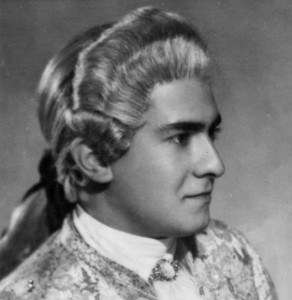 Then Roma followed in January 1947 (La Sonnambula, Manon, I pescatori di perle), Trieste in February (I pescatori di perle) and eventually Milano and La Scala in March (Manon). February 1948 he was already at the Met, where he debuted as the duke in Rigoletto and subsequently appeared as Des Grieux in Manon. He stayed during the 1948/49 season and performed in Mignon, La Traviata, L’elisir d’amore, Gianni Schicchi (Rinuccio), Falstaff (Fenton) La Bohème and Mefistofele (Faust). He also sang in Baltimore, Boston, Miami, Dallas, Los Angeles, Salt Lake City, Detroit, Pittsburgh and Cleveland during the same season. He became the lyrical sensation at the Met during these years (1948-52), yet a disaccordance led to his farewell with the house in 1952, despite his immense popularity. He returned five times to the Met, for performances in Carmen (1955), Rigoletto, Tosca and Faust (1956), and Les Contes d’Hoffman (1965).
Then Roma followed in January 1947 (La Sonnambula, Manon, I pescatori di perle), Trieste in February (I pescatori di perle) and eventually Milano and La Scala in March (Manon). February 1948 he was already at the Met, where he debuted as the duke in Rigoletto and subsequently appeared as Des Grieux in Manon. He stayed during the 1948/49 season and performed in Mignon, La Traviata, L’elisir d’amore, Gianni Schicchi (Rinuccio), Falstaff (Fenton) La Bohème and Mefistofele (Faust). He also sang in Baltimore, Boston, Miami, Dallas, Los Angeles, Salt Lake City, Detroit, Pittsburgh and Cleveland during the same season. He became the lyrical sensation at the Met during these years (1948-52), yet a disaccordance led to his farewell with the house in 1952, despite his immense popularity. He returned five times to the Met, for performances in Carmen (1955), Rigoletto, Tosca and Faust (1956), and Les Contes d’Hoffman (1965).
September 1951 saw a spectacular encounter between Giuseppe di Stefano and Maria Callas, as well as Tito Gobbi, in La Traviata in Brazil, at the Theatro Municipal of Sao Paulo. Yet another spectacular evening took place in May the following year at the Palacio de Bellas Artes in Mexico City, when Di Stefano sang again with Callas in I Puritani. In Christmas 1952 they met again in Milano for La Giaconda at La Scala.
A great moment in his career came with the staging of Lucia di Lammermoor with von Karajan at La Scala in January 1954. Lucia was played by Maria Callas, as in the 1953 performances at Firenze and Genova under Franco Ghione, after a successful appearance with Renata Tabaldi in Tosca in Milano in April 1953. Shortly after the famous recording of Tosca took place in Milano for EMI under Victor de Sabata, this time with Callas and Gobbi, topped by Sabata’s renowned recording of the Verdi Requiem in August 1953 for EMI (repeated in June 1954 at Verona). Solists were Di Stefano, Schwarzkopf, Dominguez and Siepi.
There where further performances of Tosca in Milano (La Scala) with Tebaldi in April 1954, followed by a surprisingly well performed Eugene Onegin in May, also with Tebaldi and Ettore Bastianini. Tosca was repeated in Chicago in November with Steber and Gobbi, after a successful Lucia with Callas. Von Karajan wanted him for his Carmen at La Scala in January 1955, then a crucial performance came in May 1955 at La Scala. Luchino Visconti was producing La Traviata – Carlo Mario Giulini was the conductor – and Visconti had picked Callas as Violeta, whom he worshiped and found ideal as the tragic protagonist. The media coverage and fuzz around Callas was simply too much for di Stefano, who abandoned the production after the premiere performance in protest.

He met Callas in Milano later that season for a recording of Rigoletto (EMI) under Tullio Serafin, with Gobbi in the title role, and recorded La Traviata with Antonietta Stella and Gobbi (also EMI) practically at the same time. Shortly after he travelled with La Scala and Callas to Berlin for Lucia di Lammermoor under von Karajan, where ha had some troubles and was replaced by Giuseppe Zampieri in the final scene. He appeared, however, in splendid voice in Chicago in October for I Puritani with Callas (cond. Rescigno), La Bohème with Tebaldi in November (cond. Serafin) and yet again Callas for Madama Butterfly the same month (cond. Rescigno). Then he made his first performance in 3 years at the Met. The opera was Carmen, opposite Risë Stevens, November 1955, followed by Faust with Dorothy Kirsten and Jerome Hines in December, then Rigoletto with Roberta Stevens and Robert Merrill and Tosca with Zinka Milanov and Tito Gobbi (cond. Mitropoulos) in January 1956.
1956 brought about a change of repertorty for di Stefano. He started leaning towards spinto roles, first anticipated with Carmen in Milano and New York (1955), then heavier roles such as Cavalleria Rusticana, in which he appeared in February 1956 and La forza del destino in March, both at the Teatro Massimo in Palermo under the baton of Serafin, Pagliacci in Milano under Sanzogno in April, La Gioconda in August at the Arena di Verona, conducted by Votto, Il Trovatore in Milano with Callas, under von Karajan, August/September, Aida with Stella under Votto in December and finally Mascagni’s Iris, also in December 1956, conducted by Gavazzeni and starring Boris Christoff. In between these taxing performances he had celebrated one of his greatest successes, having been invited by von Karajan to Vienna and the Staatsoper for Lucia in June. He co-starred with Callas, Panerai and Zaccaria.
Giuseppe di Stefano had become the world’s leading lyric tenor within short, but was not prone to secure his position. The breach with the Met in 1952 was just one such example, the feud with Visconti at La Scala in 1955 another. A change of repertory towards the spinto range might be considered a third. His voice was not suited for heavier roles and certainly not the manner in which he employed it. He sang with an open and uncovered note, “voce aperta,” as Lauri-Volpi called it, and with an abuse of “note spalancate,” he was risking a premature dissolution. The first symptoms were becoming apparent in the late 50’s, anticipated by asthmatic problems that were to make the rest of his career a struggle.
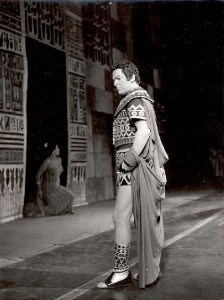
1957 he continued to appear in spinto roles: Aida, Pagliacci and La forza del destino in Milano, Iris and Carmen in Roma and in Vienna, Manon Lescaut in Napoli and Vienna, Adriana Lecouvreur in Chicago, before finally returning to his lyric repertory with L’elisir d’amore in Edinburgh, where he made his British debut at the city Festival, and La Bohème in Mexico City.
1958 he added Turandot with Serafin in Chicago to his repertory (debut in October, Birgit Nilsson was Turandot), and Andrea Chenier in Roma in March 1959. In March 1961 he starred in the world premiere of Il calzare d’argento by Ildebrando Pizzetti, performed at La Scala and conducted by Gavazzeni. He did well despite the vocal difficulties of the score, and given that Di Stefano’s vocal health was now in dubious condition, so dubious in fact that when he debuted at Covent Garden in May 1961 for performances of Tosca with Regine Crespin, he was poorly received. He returned to Covent Garden in 1963 for La Bohème with soprano Joan Carlyle, but was now in serious vocal trouble and had to cancel. He was replaced by Luciano Pavarotti, then an unknown newcomer.
Mid 60’s Di Stefano did less and less opera performances and largely confined himself to concerts and recitals. However, he attempted to take on Wagner’s Rienzi at La Scala in 1964, and was lamentably cancelled in Buenos Aires in 1965. Here he had been scheduled for Un Ballo in Maschera at the Teatro Colon, but having been an admired Cavaradossi, he was offered to sing the last performances of Tosca opposite Régine Crespin. However, Di Stefano’s vocal production was so poor that the Colon management cancelled his scheduled Ballo and dissolved the contract. A further blow came in Pasadena in March 1966, when he with poor luck attempted the role of Otello opposite Tito Gobbi.
1964 and 1965 he sang frequently in Vienna, performing in Ballo, Turandot, Madama Butterfly, Cavalleria Rusticana, Pagliacci, La Forza del Destino and Tosca. He had some success in Milano (La Scala) for Monteverdi’s L’Incoronazione di Poppea in January 1967 and undertook a large tour singing Lehar’s Das Land des Lächelns in Berlin (5/66) and Montreal, Toronto, Los Angeles, San Francisco, St. Louis and Vienna July to November 1967. Then his opera performances diminished to a few stagings per year until 1973 (he sang that year I Vespri Siciliani in Torino), when he stopped altogether. He gave now only recitals, but kept nonetheless singing throughout the 70’s and the 80’s. 1973 he accompanied Maria Callas on her final recital tour, an event that was eventually aborted in 1974.
His last performance to date came in June 1992, when he was 71 years of age and sang the role of the emperor in Turandot at the Caracalla in Roma. Di Stefano was brutally assaulted in his Kenya home in Diani Beach in November 2004 and never fully recovered from the injuries inflicted upon him. He died in his home in Santa Maria Hoe, north of Milan, on March 3, 2008.
